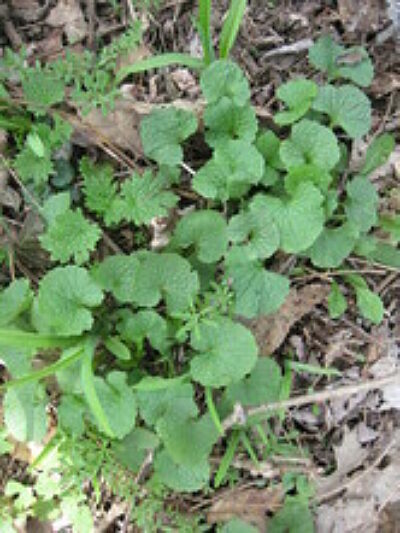Lawn Foraging
My favorite place to forage for wild foods is a springtime lawn.
Plants like clover, dandelion, ground ivy, violets, and plantain are great to eat. They’re not native plants, so you can harvest as much as you like without disrupting any fragile ecosystems. (Do bear in mind that yellow dandelions are a very important survival food for honeybees.)
The thing about spring greens is that you have to catch them before they flower. Once you see the flowers or the seeds, all the tender sweetness is gone, like bolted lettuce. As the plant flowers, the leaves change from a tasty mouthful to something very bitter. The plant is putting energy into reproduction and is “anxious” to keep from being nibbled. So it creates ill-tasting chemicals that help fend off hungry herbivores. Thus, for the true gourmet flavor of wild spring greens, get ’em while they’re young. Wild spring greens have a tangy, bold taste, so I like to blend them with store-bought lettuce to soften their punch. Beware, though, where you’re gathering: many lawn-owners apply poison chemicals.
Forest Foraging
When you’re collecting in the woods, you need to consider the environmental impact of removing plants from their native habitat. Most forest species are native and not very common. Some of the loveliest spring wildflowers taste great, but unless you’re on the verge of starvation, leave them alone. I’m all for enjoying foraging from the wild, but many native plants can be totally eradicated from the habitat. Leeks, for example, are a spring wildflower/wild food in grave danger of being eliminated by foragers.
Ferns are another common foraging target, specifically the fiddleheads. The fiddlehead isn’t a type of fern, it’s a young fern, the way a sapling is a young tree. Ferns are perennials, and each year as they rise from the soil, the fronds of most species are curled in a shape resembling the curl at the end of a violin. Can fiddleheads be eaten? The answer is…sometimes. The fiddleheads of some ferns are fairly tasty, if a bit fuzzy. However, the fiddleheads of others (such as sensitive fern) are mildly toxic. So you want to know which fern you’re harvesting.
You’ll also want to know what kind of fern you’re gathering as many ferns are increasingly rare. Some are on state lists of protected plants, some on federal endangered species lists. So enjoy fiddleheads sparingly. When foraging, please confine yourself to non-natives and leave the ferns and the other natives alone. And of course, please don’t forage at all in the woods of Landis Arboretum.
From Pest to Pesto

Garlic mustard is a pretty little wildflower with white blossoms. The leaves have a savory garlic taste, a fantastic addition to salads, quiche, and stir-fry. A lovely and useful plant, you’d think. But I spend a lot of time killing it. Ripping it out by the roots. Doing everything short of spraying a dose of pesticide on it. Why? I have an enormous tolerance for non-native “weeds,” as my undying love for dandelions shows. Why enjoy the dandelions, the clover, the daisies, and murder the poor little garlic mustard? It’s because garlic mustard is able to grow in shade while most non-native plants don’t, so they’re no threat to wilderness areas. Garlic mustard, on the other hand, will crowd out many species of woodland wildflowers and ferns. Even after the plant is completely uprooted and thrown on the compost pile, the flowers can continue producing seed. Uprooted, limp and dead-looking, they go on developing –living after death. It took me a few years to figure out why the garlic mustard grew so prolifically around my compost pile. So you have to throw the plants into the trash, then off to the landfill.
Or, you could make pesto. The chopped and blended leaves of garlic mustard are delicious when turned into pesto. And you’re helping to remove a serious threat to the forest ecosystem. Win-win!
